Retrospective Study on Seismic Ionospheric Anomalies Based on Five-Year Observations from CSES
Abstract
1. Introduction
2. Data Introduction and Processing Methods
2.1. Data Introduction
2.2. Data Processing Methods
- (1)
- In most cases, only nightside data (ascending orbit) were selected to avoid the significant impact of solar radiation on the ionosphere [33].
- (2)
- Data under disturbed space weather conditions (i.e., |Dst| > 30 nT and Kp > 3) were excluded to eliminate interference caused by space weather [34].
- (3)
- Any artificial interference was minimized by carefully selecting and applying appropriate filtering techniques. For example, the total geomagnetic field data from HPM can be interfered with by TBB signals with at most 30 nT; thus, we developed an algorithm to remove the overlapped disturbances induced by TBB [35].
- (4)
- Data were further extracted within a spatial range of ±10° around the epicenter (latitude/longitude), defined as “the EQ influential zone” according to the empirical equation put forward by Dobrovolsky et al. [14], and within a time window of 25 days before and 5 days after the mainshock based on previous research results [36,37].
- (1)
- Running quartile method
- (2)
- The difference map
- (3)
- The particle integration comparison
3. Results
3.1. An Example of EQ Case Analysis
3.2. Summative Analysis
- For over 90% of these 47 strong shallow EQs, certain anomalies were captured by at least one payload onboard CSES-01;
- For more than 65% of these 47 strong shallow EQs, two or three payloads onboard CSES-01 could simultaneously record the ionospheric anomalies before the mainshock. Among them, 45% of these EQs exhibited anomalies that were concurrently recorded by three payloads, while about 21% of these EQs displayed anomalies detected simultaneously by two payloads;
- For about 4% of these EQs, five or more payloads recorded disturbances related to the EQs.
- (1)
- Regarding electromagnetic fields, anomalies mainly manifest in the ULF and ELF bands. For ionospheric plasma parameters, fluctuations in plasma density are more frequently observed, whereas changes in plasma temperature are less common. The anomalies observed by EFD and SCM are often synchronized in time and position; the anomalies of ionospheric plasma parameters usually appear later than those in the electromagnetic field, while energy particles are closer to the time of EQ occurrence.
- (2)
- The majority of the abnormal variations detected by payloads exhibit positive anomalies, or, in other words, show enhancement phenomena.
- (3)
- The occurrence times of anomalies are predominantly concentrated in three periods: the mainshock day, within 7 days, or 11 to 15 days before the mainshock. Additionally, anomalies in the electromagnetic field are often detected as early as 20–25 days before the EQ.
- (4)
- The spatial distribution of anomalies exhibits an overall tendency to shift toward the equator, but nearly all of the anomalies fall within Dobrovolsky’s radius. Specifically, for EQs occurring in the Northern Hemisphere, anomalies tend to appear in the south of the epicenter, and vice versa in the Southern Hemisphere, though they are not as obvious as those for EQs in the Northern Hemisphere.
4. Conclusions and Discussion
- (1)
- The observations from CSES-01 under quiet space weather conditions show that during the majority (over 90%) of the 47 shallow strong EQs (Ms ≥ 7 and depth ≤ 100 km), at least one payload captured certain abnormal signals; during more than 65% of these 47 EQ cases, two or three payloads onboard CSES-01 simultaneously recorded the ionospheric anomalies in multiple physical values; and during about 4% of these EQs, five or more payloads could simultaneously record multiple ionospheric disturbances. Additionally, the larger the magnitude, the more abnormal signals appear across multiple physical values;
- (2)
- The majority of anomalies recorded by different payloads onboard CSES-01 predominantly manifest within one week before or on the mainshock day, or occasionally appear about 11–15 days or 20–25 days before the mainshock;
- (3)
- Typically, the abnormal signals detected by the CSES-01 do not appear directly overhead the epicenter, but rather hundreds of kilometers away from the epicenter, and more preferably toward the equatorward direction;
- (4)
- For the different parameters analyzed in this study, the plasma density from LAP, the electromagnetic field in the ULF band recorded by EFD and SCM, and the energetic electron in the lower energy band from HEPP show a relatively high occurrence of abnormal phenomena during the seismic activity period;
- (5)
- The anomaly recognition rates of seismic-related signals of payloads onboard CSES-01 vary: LAP, EFD, and SCM have the highest anomaly recognition rates, exceeding 70%; HEPP, HPM, and GOR have anomaly recognition rates of approximately 50%; and PAP has a low anomaly recognition rate of 24% due to contamination.
- (1)
- The lack of high-resolution observation capability
- (2)
- The challenges due to the different data processing methods lead to different anomaly extraction criteria
- (3)
- The limitation of extracting weak seismic signals under a strong and varying space background
- (4)
- The shortcomings and complexity of the LAIC mechanism
Author Contributions
Funding
Data Availability Statement
Acknowledgments
Conflicts of Interest
References
- Zhang, X.; Wang, Y.; He, X. Earthquake Disasters and Seismic Risk Reduction. China Insur. 2022, 2, 35–39. (In Chinese) [Google Scholar]
- Gokhberg, M.; Morgounov, V.; Yoshino, T.; Tomizawa, I. Experimental measurement of electromagnetic emissions possibly related to earthquakes in Japan. J. Geophys. Res. Solid Earth 1982, 87, 7824–7828. [Google Scholar] [CrossRef]
- Kon, S.; Nishihashi, M.; Hattori, K. Ionospheric anomalies possibly associated with M ≥ 6.0 earthquakes in the Japan area during 1998–2010: Case studies and statistical study. J. Asian Earth Sci. 2011, 41, 410–420. [Google Scholar] [CrossRef]
- Sarkar, S.; Choudhary, S.; Sonakia, A.; Vishwakarma, A.; Gwal, A. Ionospheric anomalies associated with the Haiti earthquake of 12 January 2010 observed by DEMETER satellite. Nat. Hazards Earth Syst. Sci. 2012, 12, 671–678. [Google Scholar] [CrossRef][Green Version]
- De Santis, A.; Marchetti, D.; Pavón-Carrasco, F.J.; Cianchini, G.; Perrone, L.; Abbattista, C.; Alfonsi, L.; Amoruso, L.; Campuzano, S.A.; Carbone, M. Precursory worldwide signatures of earthquake occurrences on Swarm satellite data. Sci. Rep. 2019, 9, 20287. [Google Scholar] [CrossRef] [PubMed]
- He, Y.; Yang, D.; Qian, J.; Parrot, M. Response of the ionospheric electron density to different types of seismic events. Nat. Hazards Earth Syst. Sci. 2011, 11, 2173–2180. [Google Scholar] [CrossRef]
- Yan, R.; Shen, X.; Huang, J.; Wang, Q.; Chu, W.; Liu, D.; Yang, Y.; Lu, H.; Xu, S. Examples of unusual ionospheric observations by the CSES prior to earthquakes. Earth Planet. Phys. 2018, 2, 515–526. [Google Scholar] [CrossRef]
- Pulinets, S.; Boyarchuk, K. Ionospheric Precursors of Earthquakes; Springer: Berlin/Heidelberg, Germany, 2004; p. 288. [Google Scholar]
- Heki, K. Ionospheric electron enhancement preceding the 2011 Tohoku-Oki earthquake. Geophys. Res. Lett. 2011, 38, L17312. [Google Scholar] [CrossRef]
- Sharma, G.; Nayak, K.; Romero-Andrade, R.; Aslam, M.M.; Sarma, K.; Aggarwal, S. low ionosphere density above the earthquake epicentre region of Mw 7.2, El Mayor–Cucapah earthquake evident from dense CORS data. J. Indian Soc. Remote Sens. 2024, 52, 543–555. [Google Scholar] [CrossRef]
- Nayak, K.; López-Urías, C.; Romero-Andrade, R.; Sharma, G.; Guzmán-Acevedo, G.M.; Trejo-Soto, M.E. Ionospheric Total Electron Content (TEC) anomalies as earthquake precursors: Unveiling the geophysical connection leading to the 2023 Moroccan 6.8 Mw earthquake. Geosciences 2023, 13, 319. [Google Scholar] [CrossRef]
- Yadav, K.S.; Vadnathani, R.B.; Goswami, K.R.; Patel, P.M. Anomalous Variations in Ionosphere TEC Before the Earthquakes of 2021 in the Different Parts of the Globe. Trends Sci. 2023, 20, 5169. [Google Scholar] [CrossRef]
- Zhu, F.; Wu, Y.; Zhou, Y.; Lin, J. A statistical investigation of pre-earthquake ionospheric TEC anomalies. Geod. Geodyn. 2011, 2, 61–65. [Google Scholar]
- Dobrovolsky, I.; Zubkov, S.; Miachkin, V. Estimation of the size of earthquake preparation zones. Pure Appl. Geophys. 1979, 117, 1025–1044. [Google Scholar] [CrossRef]
- Han, C.; Yan, R.; Marchetti, D.; Pu, W.; Zhima, Z.; Liu, D.; Xu, S.; Lu, H.; Zhou, N. Study on electron density anomalies possibly related to earthquakes based on CSES observations. Remote Sens. 2023, 15, 3354. [Google Scholar] [CrossRef]
- Hayakawa, M.; Izutsu, J.; Schekotov, A.; Yang, S.-S.; Solovieva, M.; Budilova, E. Lithosphere–atmosphere–ionosphere coupling effects based on multiparameter precursor observations for February–March 2021 earthquakes (M~7) in the offshore of Tohoku area of Japan. Geosciences 2021, 11, 481. [Google Scholar] [CrossRef]
- Pulinets, S.; Ouzounov, D.; Karelin, A.; Davidenko, D. Lithosphere–atmosphere–ionosphere–magnetosphere coupling—A concept for pre-earthquake signals generation. In Pre-Earthquake Processes: A Multidisciplinary Approach to Earthquake Prediction Studies; John Wiley & Sons: Hoboken, NJ, USA, 2018; pp. 77–98. [Google Scholar]
- Sorokin, V.; Hayakawa, M. Generation of seismic-related DC electric fields and lithosphere-atmosphere-ionosphere coupling. Mod. Appl. Sci. 2013, 7, 1–25. [Google Scholar] [CrossRef]
- Parrot, M.; Berthelier, J.-J.; Lebreton, J.-P.; Sauvaud, J.-A.; Santolík, O.; Blecki, J. Examples of unusual ionospheric observations made by the DEMETER satellite over seismic regions. Phys. Chem. Earth Parts A/B/C 2006, 31, 486–495. [Google Scholar] [CrossRef]
- Shen, X.; Zhang, X.; Yuan, S.; Wang, L.; Cao, J.; Huang, J.; Zhu, X.; Piergiorgio, P.; Dai, J. The state-of-the-art of the China Seismo-Electromagnetic Satellite mission. Sci. China Technol. Sci. 2018, 61, 634–642. [Google Scholar] [CrossRef]
- Zhima, Z.; Dapeng, L.; Xiaoying, S.; Yanyan, Y.; Shufan, Z.; Rui, Y.; Zhenxia, Z.; He, H.; Dehe, Y.; Jie, W. Current status and scientific progress of the Zhangheng-1 satellite mission. Rev. Geophys. Planet. Phys. 2022, 54, 455–465. [Google Scholar]
- Zhima, Z.; Yan, R.; Lin, J.; Wang, Q.; Yang, Y.; Lv, F.; Huang, J.; Cui, J.; Liu, Q.; Zhao, S. The possible seismo-ionospheric perturbations recorded by the China-Seismo-Electromagnetic Satellite. Remote Sens. 2022, 14, 905. [Google Scholar] [CrossRef]
- Zheng, L.; Yan, R.; Parrot, M.; Zhu, K.; Zhima, Z.; Liu, D.; Xu, S.; Lv, F.; Shen, X. Statistical research on seismo-ionospheric ion density Enhancements observed via DEMETER. Atmosphere 2022, 13, 1252. [Google Scholar] [CrossRef]
- Shen, X.; Zhang, X. The development in seismo-ionospheric coupling mechanism. Prog. Earthq. Sci 2022, 52, 193–202. [Google Scholar]
- Cao, J.; Zeng, L.; Zhan, F.; Wang, Z.; Wang, Y.; Chen, Y.; Meng, Q.; Ji, Z.; Wang, P.; Liu, Z. The electromagnetic wave experiment for CSES mission: Search coil magnetometer. Sci. China Technol. Sci. 2018, 61, 653–658. [Google Scholar] [CrossRef]
- Huang, J.; Lei, J.; Li, S.; Zeren, Z.; Li, C.; Zhu, X.; Yu, W. The Electric Field Detector (EFD) onboard the ZH-1 satellite and first observational results. Earth Planet. Phys. 2018, 2, 469–478. [Google Scholar] [CrossRef]
- Li, X.; Xu, Y.; An, Z.; Liang, X.; Wang, P.; Zhao, X.; Wang, H.; Lu, H.; Ma, Y.; Shen, X. The high-energy particle package onboard CSES. Radiat. Detect. Technol. Methods 2019, 3, 45–55. [Google Scholar] [CrossRef]
- Lin, J.; Shen, X.; Hu, L.; Wang, L.; Zhu, F. CSES GNSS ionospheric inversion technique, validation and error analysis. Sci. China Technol. Sci. 2018, 61, 669–677. [Google Scholar] [CrossRef]
- Liu, C.; Guan, Y.; Zheng, X.; Zhang, A.; Piero, D.; Sun, Y. The technology of space plasma in-situ measurement on the China Seismo-Electromagnetic Satellite. Sci. China Technol. Sci. 2019, 62, 829–838. [Google Scholar] [CrossRef]
- Zhou, B.; Yang, Y.; Zhang, Y.; Gou, X.; Cheng, B.; Wang, J.; Li, L. Magnetic field data processing methods of the China Seismo-Electromagnetic Satellite. Earth Planet. Phys. 2018, 2, 455–461. [Google Scholar] [CrossRef]
- Liu, D.; Zeren, Z.; Huang, H.; Yang, D.; Yan, R.; Wang, Q.; Shen, X.; Liu, C.; Guan, Y. The ionospheric plasma perturbations before a sequence of strong earthquakes in Southeast Asia and Northern Oceania in 2018. Remote Sens. 2023, 15, 5735. [Google Scholar] [CrossRef]
- Shen, X.; Zong, Q.-G.; Zhang, X. Introduction to special section on the China Seismo-Electromagnetic Satellite and initial results. Earth Planet. Phys. 2018, 2, 439–443. [Google Scholar] [CrossRef]
- Cao, J.; Yang, J.; Yuan, S.; Shen, X.; Liu, Y.; Yan, C.; Li, W.; Chen, T. In-flight observations of electromagnetic interferences emitted by satellite. Sci. China Ser. E Technol. Sci. 2009, 52, 2112–2118. [Google Scholar] [CrossRef]
- Liu, J.; Huang, J.; Zhang, X. Ionospheric perturbations in plasma parameters before global strong earthquakes. Adv. Space Res. 2014, 53, 776–787. [Google Scholar] [CrossRef]
- Yang, Y.; Zhou, B.; Hulot, G.; Olsen, N.; Wu, Y.; Xiong, C.; Stolle, C.; Zhima, Z.; Huang, J.; Zhu, X. CSES high precision magnetometer data products and example study of an intense geomagnetic storm. J. Geophys. Res. Space Phys. 2021, 126, e2020JA028026. [Google Scholar] [CrossRef]
- Marchetti, D.; Zhu, K.; Yan, R.; Zhima, Z.; Shen, X.; Chen, W.; Cheng, Y.; Fan, M.; Wang, T.; Wen, J. Ionospheric Effects of Natural Hazards in Geophysics: From Single Examples to Statistical Studies Applied to M5. 5+ Earthquakes. Proceedings 2023, 87, 34. [Google Scholar]
- Němec, F.; Santolík, O.; Parrot, M. Decrease of intensity of ELF/VLF waves observed in the upper ionosphere close to earthquakes: A statistical study. J. Geophys. Res. Space Phys. 2009, 114, A04303. [Google Scholar] [CrossRef]
- Wang, L.; Zhang, Z.; Zhima, Z.; Shen, X.; Chu, W.; Yan, R.; Guo, F.; Zhou, N.; Chen, H.; Wei, D. Statistical Analysis of High–Energy Particle Perturbations in the Radiation Belts Related to Strong Earthquakes Based on the CSES Observations. Remote Sens. 2023, 15, 5030. [Google Scholar] [CrossRef]
- Zhima, Z.; Hu, Y.; Piersanti, M.; Shen, X.; De Santis, A.; Yan, R.; Yang, Y.; Zhao, S.; Zhang, Z.; Wang, Q. The seismic electromagnetic emissions during the 2010 Mw 7.8 Northern Sumatra Earthquake revealed by DEMETER satellite. Front. Earth Sci. 2020, 8, 572393. [Google Scholar] [CrossRef]
- Petersen, G.M.; Büyükakpinar, P.; Vera Sanhueza, F.O.; Metz, M.; Cesca, S.; Akbayram, K.; Saul, J.; Dahm, T. The 2023 Southeast Türkiye seismic sequence: Rupture of a complex fault network. Seism. Rec. 2023, 3, 134–143. [Google Scholar] [CrossRef]
- Sarlis, N.V.; Skordas, E.S.; Christopoulos, S.-R.G.; Varotsos, P.K. Identifying the Occurrence Time of the Destructive Kahramanmaraş-Gazientep Earthquake of Magnitude M 7.8 in Turkey on 6 February 2023. Appl. Sci. 2024, 14, 1215. [Google Scholar] [CrossRef]
- Li, M.; Parrot, M. Statistical analysis of the ionospheric ion density recorded by DEMETER in the epicenter areas of earthquakes as well as in their magnetically conjugate point areas. Adv. Space Res. 2018, 61, 974–984. [Google Scholar] [CrossRef]
- Hegai, V.; Kim, V.; Liu, J. On a possible seismomagnetic effect in the topside ionosphere. Adv. Space Res. 2015, 56, 1707–1713. [Google Scholar] [CrossRef]
- Kuo, C.; Huba, J.; Joyce, G.; Lee, L. Ionosphere plasma bubbles and density variations induced by pre-earthquake rock currents and associated surface charges. J. Geophys. Res. Space Phys. 2011, 116, A10317. [Google Scholar] [CrossRef]
- Liu, J.-Y.; Chen, Y.; Chuo, Y.; Chen, C.-S. A statistical investigation of preearthquake ionospheric anomaly. J. Geophys. Res. Space Phys. 2006, 111, A05304. [Google Scholar] [CrossRef]
- Denisenko, V. Estimate for the strength of the electric field penetrating from the Earth’s surface to the ionosphere. Russ. J. Phys. Chem. B 2015, 9, 789–795. [Google Scholar] [CrossRef]
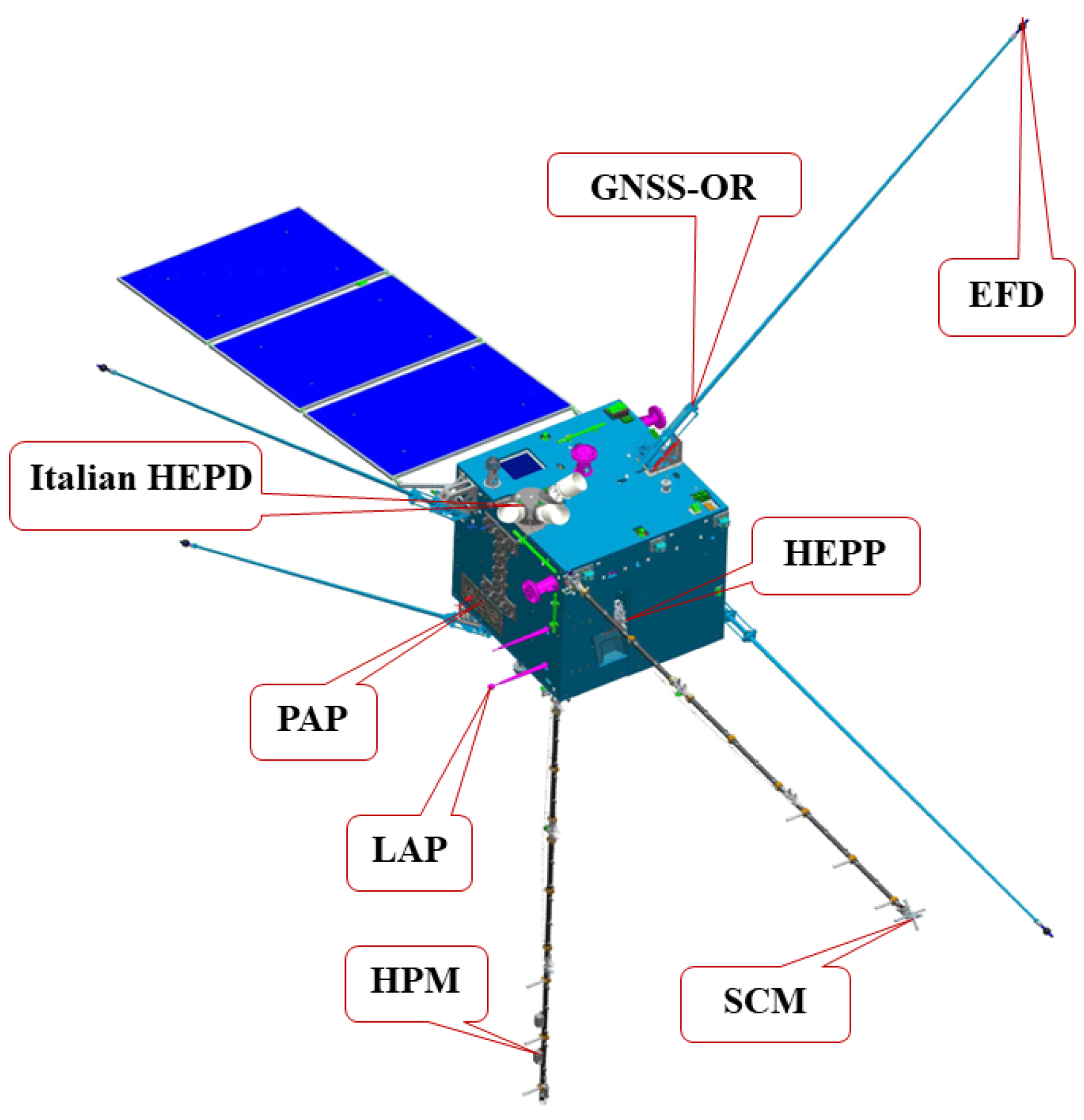
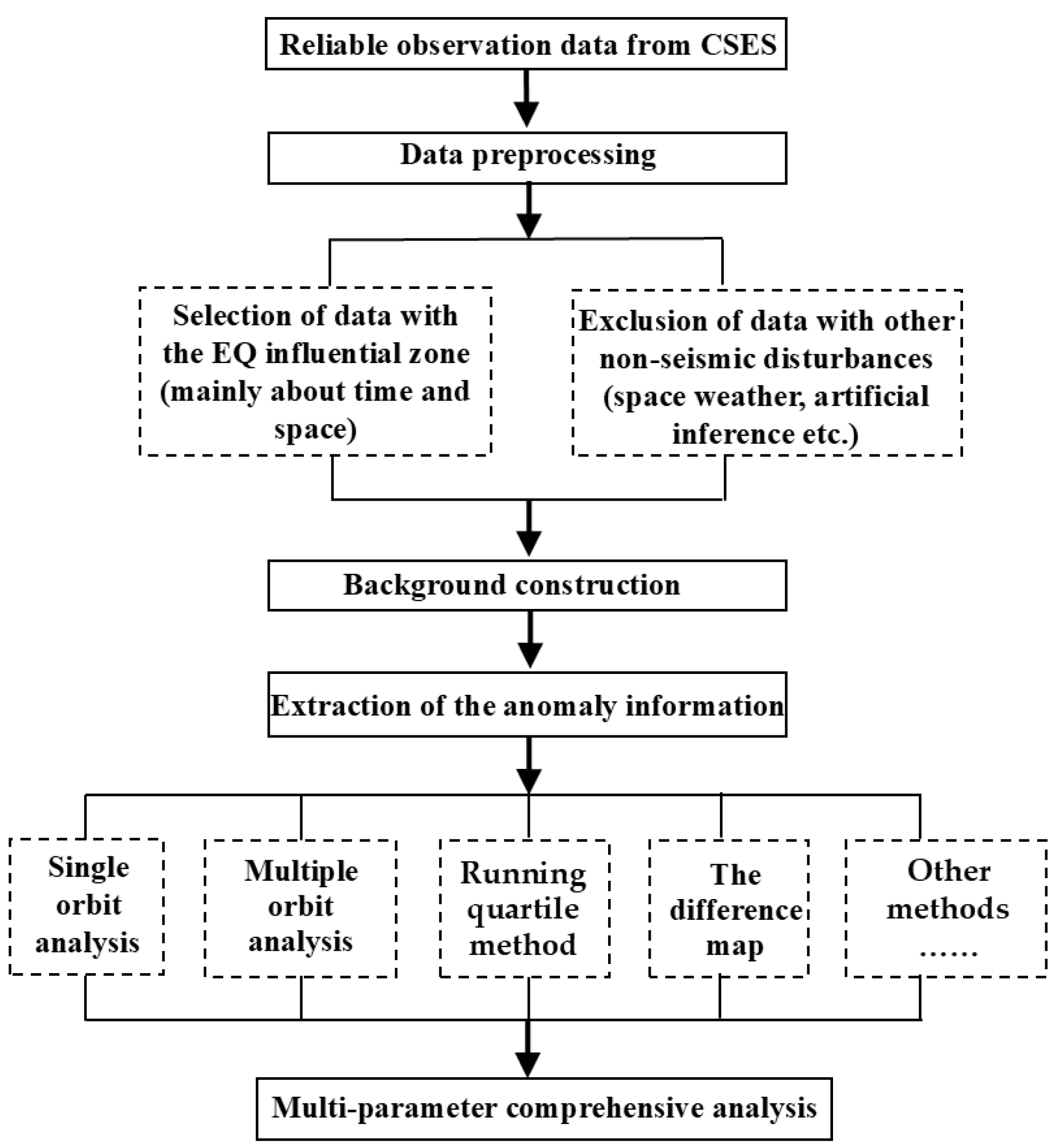
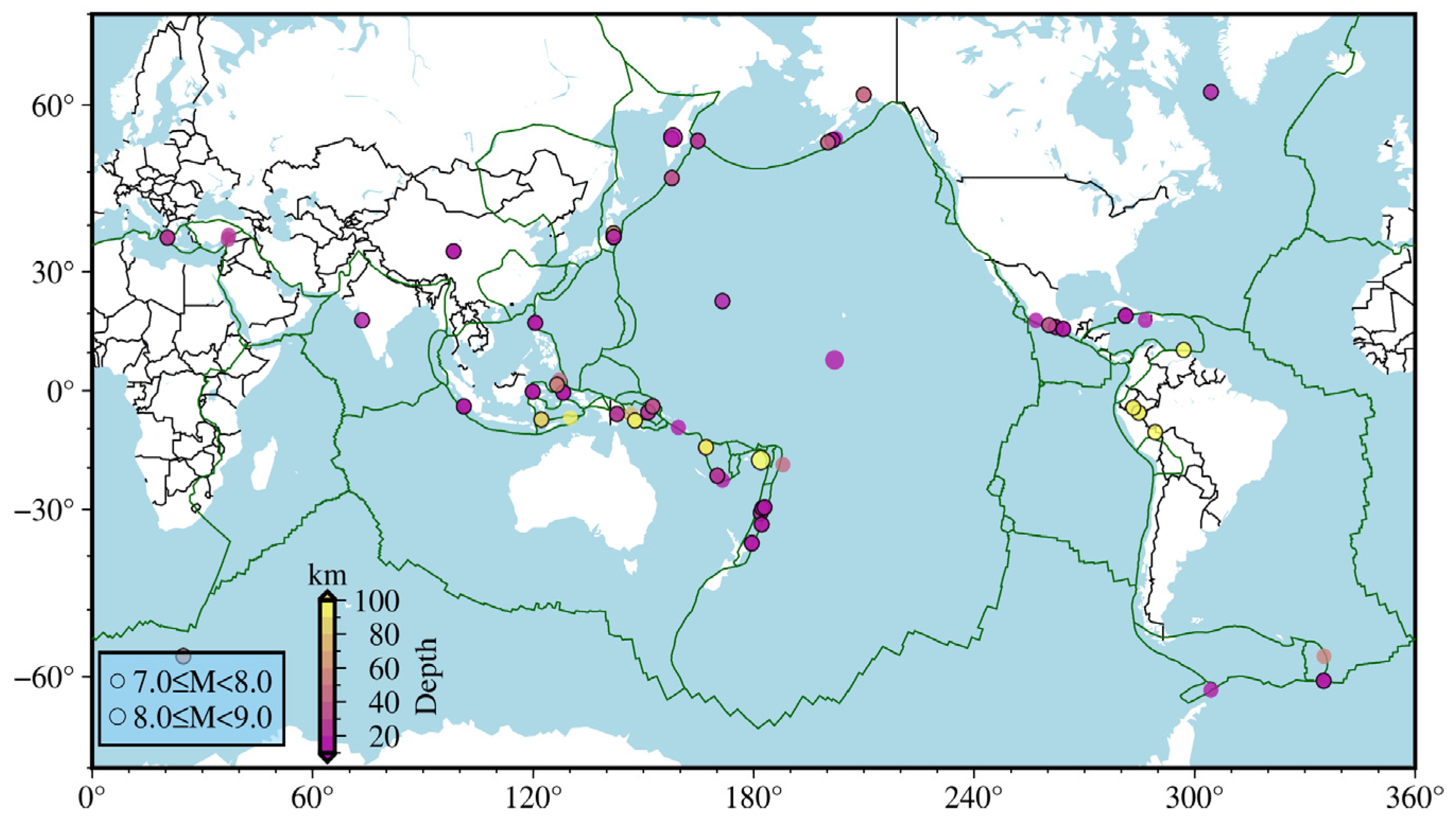
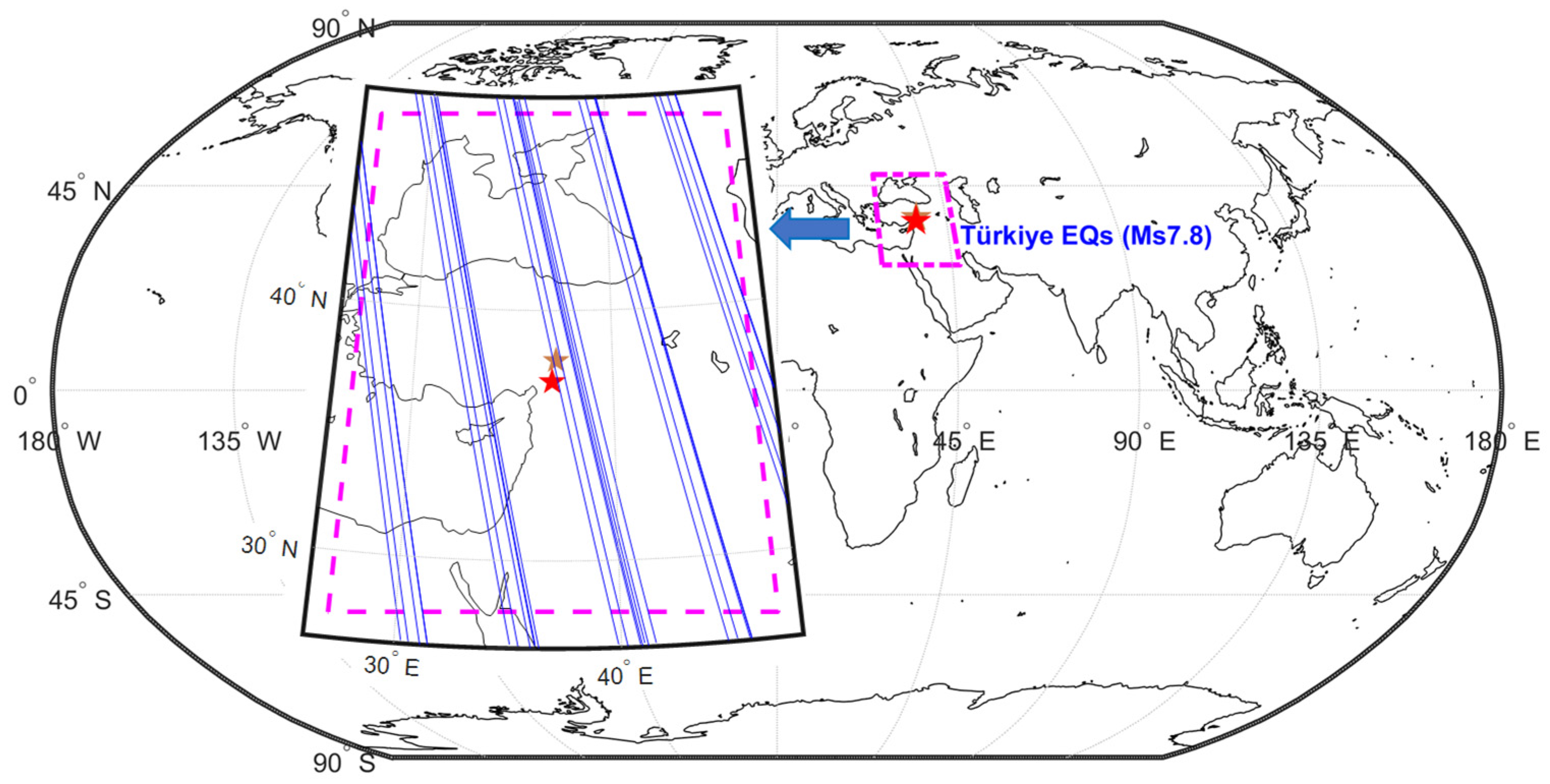


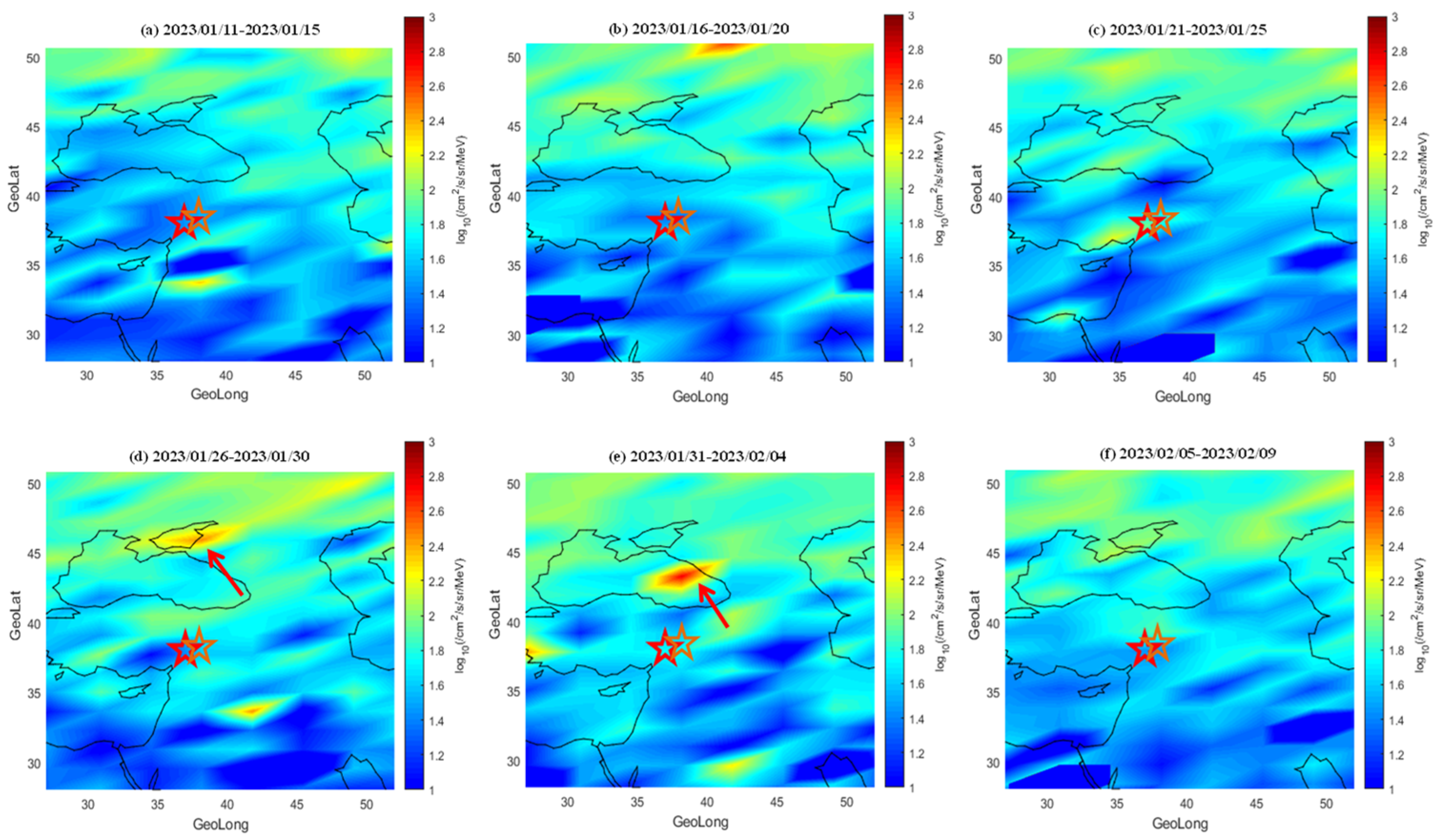

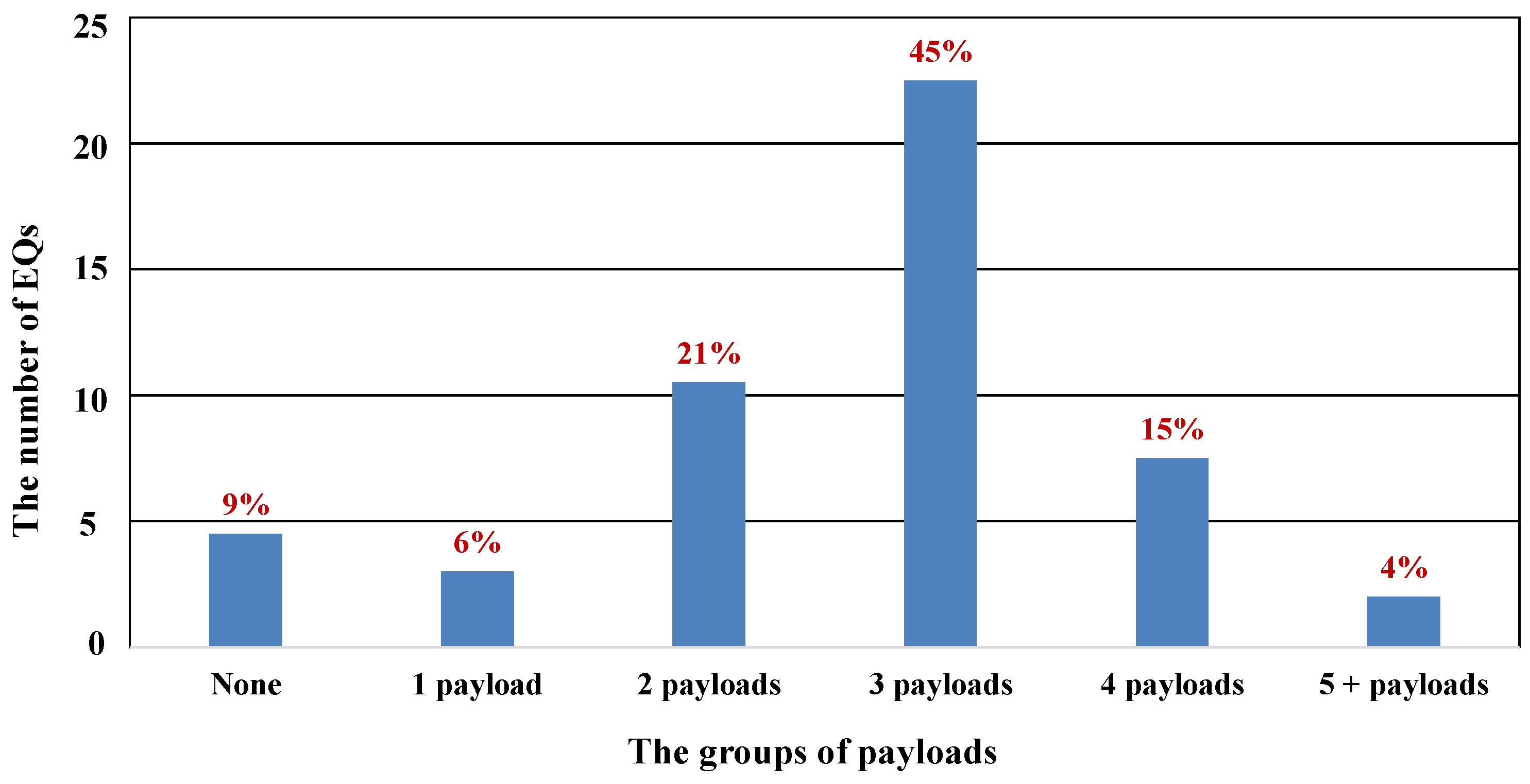
| Detection Objectives | Payloads | Parameters | Performance | Status |
|---|---|---|---|---|
| Electromagnetic field | Electric Field Detector (EFD) | The waveform and wave spectral value in ULF, ELF, VLF, and HF bands |
| ULF/ELF/VLF band in good performance; HF band with little noises |
| High-Precision Magnetometer (HPM) | The geomagnetic field vector and scalar value | DC–15 Hz | Good performance | |
| Search-Coil Magnetometer (SCM) | The waveform and wave spectral value in ULF, ELF, VLF, and HF bands |
| Good performance | |
| In situ ionospheric parameters | Plasma Analyzer Package (PAP) | Ion density (H+, O+, He+); Ion temperature; Ion drift velocity (Vx, Vy, Vz); |
| Contaminated in orbit |
| Langmuir Probe (LAP) | Electron density; Electron temperature; |
| Good performance | |
| Ionospheric structure parameters | GNSS Occultation Receiver (GOR) | TEC; Electron density profile; NmF2; | NmF2: 5 × 102–1 × 107 cm−3; | Good performance |
| Tri-Band Beacon (TBB) | Relative TEC; Ne Profile; Ionospheric scintillation index; Ionosphere tomography; |
| The 400 MHz band malfunctioned | |
| Energetic particle | High-Energy Particle Package (HEPP) | Proton flux; Electron flux; |
| Good performance |
| High-Energetic Particle Detector (HEPD) | Good performance |
| Global Shallow EQs with Ms ≥ 7 and Depth ≤ 100 km | ||
|---|---|---|
| The Number of EQs Analyzed | The Number of EQs with Anomalies | |
| SCM | 38 | 27 |
| EFD | 32 | 23 |
| HPM | 47 | 24 |
| PAP | 38 | 9 |
| LAP | 38 | 28 |
| GOR | 32 | 15 |
| HEPP | 38 | 22 |
| Payload | The Sensitive Parameter | Abnormal Phenomena | Anomalies Occurring Time | Anomalies Occurring Position |
|---|---|---|---|---|
| SCM | Waveform and spectrum in the ULF band | Positive anomalies with a change amplitude exceeding 20% | 5–10 days, 20–25 days before the EQ, and on the mainshock day; | Anomalies overall shift to the equator direction |
| EFD | Waveform and spectrum in the 19.5–250 Hz band | Positive anomalies with more than 2σ of variation | 5 days before the EQ, 10–15 days and 20–25 days before the EQ | Anomalies overall shift to the equator direction |
| HPM | East component of the magnetic field | Magnetic disturbance of 2–3 nT | From 4 days before the EQ to the day of the EQ | Random |
| PAP | NO+, Vertical drift velocity of ions (Vz) | Positive abnormal disturbance of NO+ with over 50% change amplitude; Both positive and negative perturbations of Vz | 1–5 days before the EQ | Southwest of the epicenter |
| LAP | Ne | An increment with 100% amplitude change | Within 3 days before the EQ; 5–7 days and 11–13 days before the EQ | East of the epicenter |
| GOR | NmF2 | Abnormal increase in NmF2 | 1–7 days before the EQ | Southeast of the epicenter |
| HEPP | Electron flux | An enhancement of more than 0.5 magnitudes | Within 5 days before the EQ | Northeast and east of the epicenter |
Disclaimer/Publisher’s Note: The statements, opinions and data contained in all publications are solely those of the individual author(s) and contributor(s) and not of MDPI and/or the editor(s). MDPI and/or the editor(s) disclaim responsibility for any injury to people or property resulting from any ideas, methods, instructions or products referred to in the content. |
© 2024 by the authors. Licensee MDPI, Basel, Switzerland. This article is an open access article distributed under the terms and conditions of the Creative Commons Attribution (CC BY) license (https://creativecommons.org/licenses/by/4.0/).
Share and Cite
Yan, R.; Huang, J.; Lin, J.; Wang, Q.; Zhang, Z.; Yang, Y.; Chu, W.; Liu, D.; Xu, S.; Lu, H.; et al. Retrospective Study on Seismic Ionospheric Anomalies Based on Five-Year Observations from CSES. Remote Sens. 2024, 16, 4426. https://doi.org/10.3390/rs16234426
Yan R, Huang J, Lin J, Wang Q, Zhang Z, Yang Y, Chu W, Liu D, Xu S, Lu H, et al. Retrospective Study on Seismic Ionospheric Anomalies Based on Five-Year Observations from CSES. Remote Sensing. 2024; 16(23):4426. https://doi.org/10.3390/rs16234426
Chicago/Turabian StyleYan, Rui, Jianping Huang, Jian Lin, Qiao Wang, Zhenxia Zhang, Yanyan Yang, Wei Chu, Dapeng Liu, Song Xu, Hengxin Lu, and et al. 2024. "Retrospective Study on Seismic Ionospheric Anomalies Based on Five-Year Observations from CSES" Remote Sensing 16, no. 23: 4426. https://doi.org/10.3390/rs16234426
APA StyleYan, R., Huang, J., Lin, J., Wang, Q., Zhang, Z., Yang, Y., Chu, W., Liu, D., Xu, S., Lu, H., Pu, W., Wang, L., Zhou, N., Li, W., Tan, Q., & Zhima, Z. (2024). Retrospective Study on Seismic Ionospheric Anomalies Based on Five-Year Observations from CSES. Remote Sensing, 16(23), 4426. https://doi.org/10.3390/rs16234426










